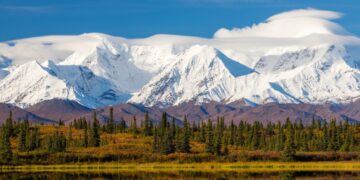Animals come in a diverse range of shapes and sizes. While there are some obvious answers, a few creatures are the largest of their kind, reaching a sheer size we never expected to see. The largest animals in the world definitely catch our eye although some may reside in far off locations which are difficult for us to reach. Irrespective of their size all animals play an important role in the ecosystem.
Here are the top 20 biggest animals in the world.
1. Capybara (Largest rodent in the world)
Capybara is a large rodent which is native to South America. It is the biggest rodent in the world. It is closely related to the guinea pig. Capybaras reside in savannas and thick forests and prefer to live near water bodies. As a species capybaras are highly sociable, and usually live in groups of 10 to 20 individuals, with some communities consisting of as much as 100 capybaras.
While they are not a threatened species, capybaras are hunted for their meat, hide as well as the grease from their fat which is used extensively in pharmaceutical industries. It is also one of the most affectionate animals towards humans. Capybaras have sweat glands on the hairy portions of their skin, which is a unique feature in contrast to other rodents. It also lacks a down hair (which acts as an insulating blanket and keeps the body warm) and has only guard hair which is unusual for a furry animal.
On average, it is about 120 cm long and stands about 56 cm tall and weighs between 35 to 66 kgs. The size varies according to gender, with female rodents being comparatively bigger than the males. They are semi-aquatic mammals, usually prefer to reside in moist environments like rivers, streams, marshes, and estuaries. They have an herbivorous diet feeding mainly on grasses, aquatic plants, fruits, and barks of trees growing in or near the water bodies.
2. Chinese Giant Salamander (Largest amphibian in the world)
Chinese Giant Salamander is the largest amphibian in the world. It is an aquatic species and is endemic to the lakes in Yangtze River basin and mountain streams in China. These animals are about the same size as the average human lying down, weighing about 30 kgs and measuring about 115 cm long. Their tails comprise more than half of their total body length.
They are nocturnal animals. Their diet consists of insects, fish, worms, crabs, and smaller amphibians. Due to their poor eyesight, they rely on the vibrations in the water to capture their prey. These salamanders live underwater and breathe through their skin. They produce a sticky, white secretion to ward off predators.
Due to the destruction of their habitat as well as their consumption as a delicacy and use in traditional medicine, the Chinese Giant Salamander is now a critically endangered species. It is famous for its vocalizations and can make barking, hissing, whining, and crying sounds. In the Chinese language, it is known as infant fish as some of its vocalizations is quite similar to the crying sounds made by a human child.
3. Komodo Dragon (Largest lizard in the world)
One of the apex predators, Komodo Dragon is the largest species of lizard in the world, and it found in the Indonesian islands. On average it grows up to 3 meters and weighs about 70 kgs. Due to their large size, Komodo Dragons dominate the ecosystem in which they live. Their diet consists of a large variety of smaller animals and reptiles. They also occasionally attack humans. They are classified as a vulnerable species.
They hunt by ambushing their prey and delivering a venomous bite. Even if the game escapes, the animal is sure to die within a day due to blood poisoning. Being born with a superior sense of smell, the Komodo Dragon can easily track the prey and finish the hunt. They are solitary creatures and come together only to breed. They are also listed as one of the toughest animals in the world.
4. Saltwater Crocodile (Largest reptile in the world)
Saltwater Crocodiles are one of the largest reptiles in the world. They deadly predators native to South Asia and Australia. On average, the males of this species weigh about 1,000 kgs and are about 6 meters long. They inhabit saltwater and brackish wetlands across eastern India and Southeast Asia. It is a hyper carnivorous apex predator who ambushes and swallows its prey. These dangerous animals are opportunistic feeders who wait just below the water surface.
They can feed on various animals, including small and large mammals, birds, fishes, and even humans. They mate during the rainy season when water levels are the highest and the females lay about 40 to 60 eggs. Female Saltwater Crocodiles care remarkably for their offspring. Saltwater Crocodiles have a life expectancy of 70 years with some living up to 100 years. It is listed as one of the aggressive animals in the world.
5. Wandering Albatross (Largest bird in the world)
Wandering Albatross is the largest bird. It is a seabird found in the Southern Ocean. It has the longest wingspan for any bird, at about 3 meters on an average. The albatross breeds every year and lays one white egg with a few spots in grassy vegetation. They are a monogamous species. Early explorers believed that evil would befall if these birds were shot. Wandering Albatrosses also travel wider distances across the ocean to forage for food, while other albatrosses look for food in shallower waters near the mainland. They also forage in colder waters. They mainly feed on small fish crustaceans and on animal refuse in the sea.
6. Common Ostrich (Largest flightless bird in the world)
Common Ostrich is the largest species of flightless birds and is found in Africa, where they reside in arid and semi-arid regions. On average they weigh about 104 kgs and are about 2 meters tall. They lay the largest eggs among living birds, each reaching a length of around 6 inches. They have long neck and legs and can run at a speed of 55 km/h. One of the most interesting facts about this herbivorous bird is that they have three stomachs.
Their diet consists mostly of plants although they eat invertebrates as well. The myth of ostriches burying their hands in sands to avoid danger is false. Ostriches are famous for their large feathers and are farmed for it around the world. When cornered by a predator, they attack by a kick with their powerful legs, and they can easily slay humans or any other animal with a single kick.
7. Giraffe (Tallest animal in the world)
Giraffe is the tallest animal in the world. On average, they are about 14 to 19 meters tall. They are distinguished by their long neck. Giraffes inhabit savannahs and open woodlands. Giraffes feed on the twigs of trees. They are usually found in groups with numbers up to 66 individuals. Giraffes require less food than other herbivores as the foliage they consume has more nutrients and they have a more effective digestive system.
8. African Bush Elephant (Largest terrestrial animal in the world)
One of the biggest animals in the world, the African Bush Elephant is the largest terrestrial animal in the world. They can grow up to a length of 7.3 meters tall while reaching a height of 4 meters, making them one of the biggest animals in the world. They are found in 37 African countries. They inhabit a wide range of habitats from grasslands, subtropical and temperate forests, wetlands, woodlands and agricultural lands.
An elephant society comprises of large herds of females (cows), their daughters and their pre-pubescent male offsprings. Adult males (bulls) live alone or live in small bachelor groups. They are herbivorous and feed primarily on grasses, fruits, creepers, herbs, barks, leaves, and other types of vegetation making up a large part of their diet.
Adult male African elephants are usually larger than females and can weigh up to 10,000 kgs. To maintain their colossal size, they need to consume close to 160 kgs of food every day. These animals have an average lifespan of 70 years in the wild. Both the males and female animals of this elephant species have tusks and are vulnerable due to habitat destruction and poaching for ivory.
9. Colossal Squid (Largest squid in the world)
Colossal Squid is the largest species of squid in the world. On average, they weigh about 495 kgs, though the largest among them may weigh about 700 kgs, which would make them the largest invertebrate. They have a length of about 9 to 10 meters. They inhabit the Southern Ocean, near Antarctica. Not much is known about its behavior, but it is accepted that they use bioluminescence to attract prey. They are an ambush predator, and themselves are preyed upon by sperm whale. Studies related to the species also suggest the possibility of cannibalism within the species.
10. Blue Whale (Largest sea animal in the world)
One of the types of whales, Blue Whale is a marine mammal considered the biggest and heaviest animal ever known to exist, even larger than dinosaurs. They are found across all major oceans except the Arctic Ocean and the Bering Sea. Blue whales were widely found abundantly across the oceans at the end of the 19th century, but whaling drove them nearly to extinction. They feed primarily on small shrimp-like crustaceans called krill. These giant mammals can consume about 3,630 kgs of krill daily.
Blue whales have vocalizations that include the loudest and lowest frequency sounds made by any animal. Their call of 188 decibels is louder than a jet engine. These creatures have absolutely massive hearts. It’s the biggest heart out of any other mammal in the animal kingdom. It weighs about 180 kgs in itself and can be roughly the size of a small car. As the blue whale dives deeper into the depths of the sea, its heart will only beat twice per minute.
Adult blue whales are bluish-gray and are about 30 meters long and can weigh as much as 181,437 kgs, more than twice as much as the largest dinosaur. Despite their heavy bodies, they are good swimmers and can reach a maximum speed of 32.2 km/h when needed. But they usually prefer to move at a slow pace of 8 km/h. They have a long lifespan, with the average being around 80 to 90 years.
11. Red Kangaroo (Largest marsupial in the world)
The red kangaroo is the largest of all species of kangaroo and the largest marsupial in the world. They are also the largest terrestrial mammal native to Australia, where it can be found across the majority of the mainland. These kangaroos can reach up to 1.6 meters from head to rump with their tail reaching 1.1 meters long and can weigh around 90 kgs. The males can cover 8 to 9 meters in one leap while reaching heights of 1.8 to 3 meters.
12. Harpy Eagle (Largest eagle in the world)
Harpy Eagle is the largest species of an eagle on planet Earth. It is mostly seen in Central and South America. The species is threatened because of habitat loss and intentional killing by the humans in the wild. It can reach up to 34 to 42 inches in length and 4 to 9 kgs of weight. Talking about the appearance, both males and females look identical with black backs, grey face and white belly. They mate for a lifetime and both the paired of harpy eagles will occupy the territory of 20 square miles. The average lifespan of species is 25 to 35 years in the wild.
13. Ocean Sunfish (Largest bony fish in the world)
Ocean Sunfish also knew as common mola is the largest and heaviest known bony fishes in the world. It can weigh between 247 and 1,000 kgs and mostly seen in the tropical and temperate waters around the world. It used to consume largely small fishes, fish larvae, squid, and crustaceans. Talking about the appearance, it has a flattened body, and it looks taller when their dorsal and ventral fins are extended.
14. Green Anaconda (Largest snake in the world)
Green Anaconda is the longest snake in the world with an average length of 6 meters and a top length of 8.8 meters. The weight is approximately 250 kgs which makes it heaviest of all snakes in the world. The snake species is native to South America and prefer swamps, marshes, and streams. It spent most of the time in hunting underwater and use both sight and smell to hunt. They prey on various mammals, fish, amphibians, and aquatic animals.
The green anaconda is not venomous and uses constriction to hunt its prey. They are usually dark green with large black spots on their backs and smaller yellowish spots on the sides. Their nostrils are positioned at the top of their heads, which allows them to breathe even when submerged underwater. It can read up to 10 years in the wild and live up to 30 years in captivity.
15. Japanese Spider Crab (Largest arthropod in the world)
Japanese Spider Crab is the species of crab and the largest arthropod in the world. It is mostly seen on the Pacific side of the Japanese islands. These omnivorous crabs are named so due to their resemblance to spiders. The males are generally bigger than the females. It has the largest leg span of any arthropod in the world that can reach up to 3.8 meters long and weighing up to 18.6 kgs, however, the actual body is 15 inches long.
The species has 8 legs and 2 arms that are primarily used for feeding. They can live up to 100 years in the wild, the longest lifespan among all crab species. However, as these crabs are considered a delicacy in some Asian countries, their populations are declining due to fishing.
16. Goliath Frog (Largest frog in the world)
Goliath Frog is the largest frog in the world which is native to restricted areas in Cameroon and Equatorial Guinea. It can reach up to 12.5 inches in length and weight around 3.3 kgs. Talking about the appearance, the dorsal side of the species is covered with green colored skin and has a granular texture, however, the underside of the body is yellow-orange colored. It can leap up to 3 meters and known for its large eyes and an acute sense of hearing. The average lifespan of the Goliath Frog is 15 years in the wild and up to 21 years in the captivity.
17. Polar Bear (Largest land predator in the world)
The biggest land predator animal is the Polar Bear. These massive arctic creatures can grow to be around 3 meters tall. They weigh about one-tenth as much as the largest elephant, or about 590 kg, making them the largest carnivores roaming the Earth. One interesting fact about them is that they aren’t actually white. Polar bears are born toothless and blind, with a layer of short white fur covering their bodies. Their fur is actually clear, and their skin is black.
Polar bears are excellent swimmers and propel themselves through the water with their front paws. These are marine mammals, who spend a considerable part of their time hunting for seals, their favorite prey, in the chilly Arctic waters. They can live up to 15 to 18 years in the wild. Unfortunately, these large carnivores are currently an endangered species, with climate change contributing to the loss of their habitat.
18. Titan Beetle (Largest insect in the world)
Native to parts of the South American rainforests, the Titan Beetle is the largest and heaviest insect found on Earth. However, these beetles have a short lifespan of only a few weeks, during which they do not feed. Instead, they survive on the reserves stored within their bodies during their pupa stage. Reaching up to a length of 6.5 inches, they are among the biggest animals in the world belonging to the insect family. These beetles are usually reddish-brown, with some areas being darker than the rest of the body. They have powerful mandibles capable of breaking a wooden pencil in half. They are nocturnal insects that prefer to lead a secluded life.
19. Killer Whale (Largest dolphin in the world)
Orcas or killer whales are large marine predators found in all oceans. But, unlike what their name suggests, they aren’t whales but are the largest species of dolphins in the world. They were originally named “whale killer” by sailors who observed them hunting larger whales in groups. The name was later turned around.
These dolphins feed on fishes, seals, sharks, whales, and other marine species. The largest recorded killer whale was around 9.8 meters in length and weighed close to 10,000 kgs. However, their sizes may vary. These are social creatures with an average lifespan of 29 to 50 years in the wild.
20. Whale Shark (Largest fish in the world)
The whale shark is a beautiful marine animal with a gray body with white spots and markings. Reaching up to a length of around 14 meters, these gentle giants are the largest species of fish on the planet, after the blue whale, of course. They are similar in size to some whale species, thus earning their name. These fishes can be found in the warmer currents of the Indian, Pacific, and Atlantic oceans.
As filter feeders, their diet consists mainly of smaller fish, crustaceans, and plankton found abundantly in oceans. Along with being one of the biggest animals in the world, whale sharks also have a long lifespan – they can live up to 150 years in the wild. However, they are declining due to illegal fishing for their fins, meat, and oil.


































































































































































































